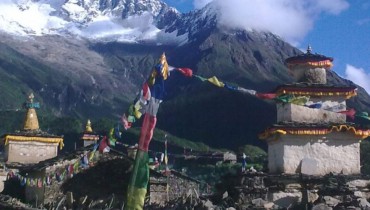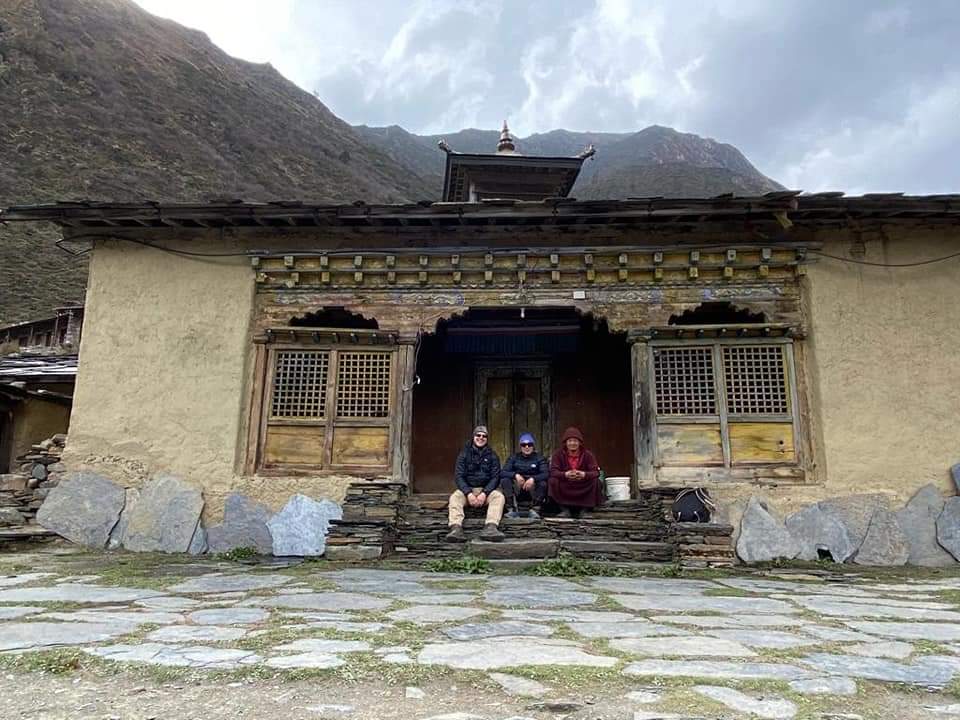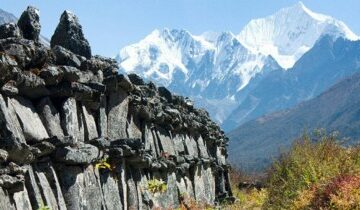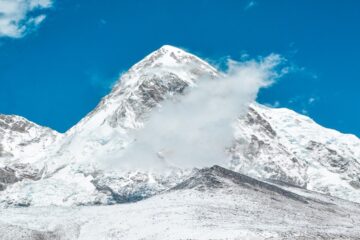Tsum Valley, the most isolated & serene valley in the lap of Himalayas is as beautiful culturally as it is naturally. Trek to Tsum Valley is Nepal’s one of the gems of the treks that has incredible Himalayan vistas, nomadic culture, spiritual Buddhism and the most wonderful people.
The region lies very close to the quake epicenter and hence has been affected at few places. However, Tsum Valley Trek has not lost its glory. The Himalayan peaks like Manaslu, Singri, Himalchuli & Ganesh among others are a great feast for the eyes; whereas cultural encounters in villages like Chumling, Chhokungparo & Burgi are out of the world. The spirituality trekkers get to experience in highland monasteries like Rachen Gompa and Mu Gompa are incomparable.
Trekkers in Nepal are allowed to trek as FIT (Free Individual Trekker) or in a group of various sizes. However, there are certain trekking regions known as ‘Restricted Areas’ that are highly regulated by the Government of Nepal, and hence FITs are strictly forbidden. Trekking in these areas is allowed only upon acquiring a permit from the Department of Immigration.
Interested trekkers should contact the authorized trekking agencies who then can apply for permits (on behalf of trekkers) at the Department of Immigration fulfilling all the necessary formalities. Trekkers should be trekking in a group (of a minimum of two persons) accompanied by a licensed trekking guide. Individual trekkers cannot apply for the permit.
Outline Itinerary
Day 01: Arrive at Kathmandu, Transfer to the Hotel
Day 02: Rest Day at Kathmandu, Obtain Special Permit
Day 03: Drive from Kathmandu to Maccha khola|Altitude: 700m/2296ft|Drive: 6-7hrs|Meal: BLD
Day 04: Trek From Macchakhola Gaon to Jagat|Altitude: 2340m/7676ft|Trek: 7-8hrs|Meal: BLD
Day 05: Trek to Lokpa|Altitude:2240m|Trek: 5-6hrs|Meal:BLD
Day 06: Trek to Chumling|Altitude: 2386m|Trek: 5-6hrs|Meal: BLD
Day 07: Trek to Chokung paro|Altitude: 3030m|Trek: 5-6hrs| Meal: BLD
Day 08: Trek to Nile|Altitude: 3361m|Trek: 6-7hrs|Meal: BLD
Day 09: Trek to Mu Gompa- Monastery stay|Altitude: 3700m|Trek:5-6 hrs|Meal: BLD
Day 10: Trek to Nar- Visit Rachen Gumba and back to Chokung Paro|Trek:4-5hrs|Meal:BLD
Day 11: Trek to Chumling|Trek: 5-6 hrs|Meal: BLD
Day 12: Trek to Philim|Trek: 5-6 hrs|Meal: BLD
Day 13: Trek to Dovan|Trek: 5-6 hrs|Meal: BLD
Day 14: Trek to Sotikhola and Drive back to Kathmandu| Trek: 5-6hrs|Meal: BL| Drive: 7-8 hrs
Day 1: Arrive at Kathmandu, Transfer to the Hotel+
Day 2: Rest Day at Kathmandu, Obtain Special Permit+
Day 3: Drive from Kathmandu to Maccha khola|Altitude: 700m/2296ft|Drive: 6-7hrs|Meal: BLD+
Day 4: Trek From Macchakhola Gaon to Jagat|Altitude: 2340m/7676ft|Trek: 7-8hrs|Meal: BLD+
Day 5: Trek to Lokpa|Altitude:2240m|Trek: 5-6hrs|Meal:BLD+
Day 6: Trek to Chumling|Altitude: 2386m|Trek: 5-6hrs|Meal: BLD+
Day 7: Trek to Chokung paro|Altitude: 3030m|Trek: 5-6hrs| Meal: BLD+
Day 8: Trek to Nile|Altitude: 3361m|Trek: 6-7hrs|Meal: BLD+
Day 9: Trek to Mu Gompa- Monastery stay|Altitude: 3700m|Trek:5-6 hrs|Meal: BLD+
Day 10: Trek to Nar- Visit Rachen Gumba and back to Chokung Paro|Trek:4-5hrs|Meal:BLD+
Day 11: Trek to Chumling|Trek: 5-6 hrs|Meal: BLD+
Day 12: Trek to Philim|Trek: 5-6 hrs|Meal: BLD+
Day 13: Trek to Dovan|Trek: 5-6 hrs|Meal: BLD+
Day 14: Trek to Sotikhola and Drive back to Kathmandu| Trek: 5-6hrs|Meal: BL| Drive: 7-8 hrs+
Service Includes:
Airport transfer with an escort in a private vehicle.
2 nights’ accommodation at Tourist Standard Hotel in Kathmandu with breakfast in twin accommodation
11 nights’ accommodation at Mountain Lodge or Homestay on a sharing basis during the trek
Full board meals during the trek (Breakfast, Lunch, Dinner, tea & coffee, seasonal fruits, chocolate/s & biscuits)
English speaking, First Aid and Eco-trained local trekking guide, Assistance guide as per the group size, porters (2:1)
All the expenses for guide and porters along with Insurance
Manaslu Conservation Area Project (MCAP) fee
Tsum Valley Special permit
Private Vehicle Transfer from Kathmandu/Machha Khola
Private Vehicle Transfer back to Kathmandu
Exclusive medical kit bag, Duffle Bag, Trekking T-shirt, Adventure Certificate
Sleeping Bag and Down Jacket during Trek- need to return back after trek
All government and local taxes as applicable
Service Excludes:
Nepal Visa – (Cost- US$- 30 for 15 days & $- 50 for 30 days)
Lunch & evening meals while in Kathmandu (Except welcome/farewell dinner)
Travel insurance
Cost of personal nature expenses, Beverages (Mineral water or coca-cola), cost of extra meals, snacks, phones bills, Internet, WiFi, laundry etc.
The cost incurred during emergencies, evacuations
Tips for Guide/porters/driver …
Nepal Visa & Getting in to Nepal
All the foreign nationals (except Indian nationals) are required to display Visa while entering Nepal. Nepalese Visa can be obtained either at Nepalese Embassy of respective country or can be obtained during your arrival at the International Airport in Kathmandu or from the Nepal’s border entry point. However, certain nationals are requested to arrange Visa prior to arrival in Nepal. The listed countries are- Afghanistan, Iraq, Cameroon, Ghana, Somalia, Swaziland, Palestine, Zimbabwe, Nigeria, Ethiopia and Liberia and cannot secure Nepalese Visa on arrival.
Requirements: Traveler should have a valid passport for at least six months, recent digital photos (size: 1.5″ x 1.5″) and Visa fees (either US$ or equivalent) mentioned as below:
Visa Facility Duration Fee
Multiple entry 15 days US$ 30 or equivalent Nepalese currency
Multiple entry 30 days US$ 50 or equivalent Nepalese currency
Multiple entry 90 days US$ 125 or equivalent Nepalese currency
You can also download VISA form and fill up. Please go through the link as below:
https://www.immigration.gov.np/page/visa-on-arrival
Group Size:
For group, we normally run with minimum 2 person to maximum 10 in our published group departure program. However, there is no barrier for a private trip. We can run a trip for single person and even more than 10 in a group. Normally for a group, we provide 1 main guide, 1 assistance guide along with 1 porter for every 2 trekkers. Moreover, for every additional 2 trekkers, 1 more assistance and a porter will be provided making a team combination as follows:
Minimum to 2 PAX: 1 Guide and 1 porter
4-6 PAX: 1 guide, 1 assistance guide and 3 porter
7-10 PAX: 1 guide, 2 assistance guide and 4/5 Porter
Guide and Trip Safety
Once, you confirm your trip, it is our responsibility to make your trip wonderful without creating any difficulties. Hence, we have prepared our itinerary in such a way that it will properly acclimatize you. Also, we request you in advance to have regular exercises and make habits to walk in a daily basis. Similarly, during trek, you will be fully guided by our professional trekking guides and supporting team. They are properly trained in regards to safety and first aid. Even, we have every set up in case of emergency such as high altitude medicine and Gammow Bag (High altitude Chamber bag). Please note High altitude Chamber Bag is used to provide heat in your body and it is available on certain cost. Moreover, to let you familiar with altitude, you are suggested to walk slow and steady and ensure for proper acclimatization.
For trekking, we provide local experienced guide speaking fluent English and familiar with the local routes, landscape, flora, fauna as well as culture, and tradition of certain areas and let you feel comfortable. We do not encourage for child labor, hence, our porter will be above 16 years that are living in the Himalayas of Nepal; as well as carries only 20-22 kg weight per porter. Normally, the guide and support teams are selected with proper analyzing of their experience, leadership skills and personal aptitude. Our guides are well familiar with different societies of all caste and customs along the trail and share the insight culture with you that are not even noted in guide book.
To make our staffs more fluent and experienced, we consistently provide trainings. They have been participating in special training programs like Trekking guide training, Rock climbing, Ice climbing, Intensive Wilderness first Aid and many more that has been certified and approved by Nepal Government.
Meals and Accommodation
During your stay in Kathmandu, we accommodate you in 3 star category hotel in a comfortable and relaxing environment. Breakfast is included with room accommodation. Normally, based on your group size, you will be accommodated in twin and triple sharing basis. Likewise, in case of single room stay in a group, you will require to pay single supplement charge mentioned in our trip cost. Also, if you wish to upgrade hotel accommodation, we can accommodate you in respective hotels with surcharge. On your arrival in Kathmandu and a day before your departure for homeland, we Hiking Nepal Team will invite you for Welcome and Farewell dinner. You will be taken to an authentic restaurant serving Nepali Cuisine with some cultural Dance Show. For your other day’s meals, you can get hygienic restaurants providing verities of taste including continental, Chinese, Italian, Nepalese and many more.
Similarly, for your stay during trek, we shall accommodate you in local lodge available en-route. Normally, the rooms are basic and in a twin sharing basis. Some lodges offer shower system and hot water.
For meals, you will be served sufficient hygienic food. Our service includes a full board meals (Breakfast, Lunch, Dinner and Tea/Coffee) based on lodge menu. Normally, for breakfast; porridge, cereals, toast or chapattis, omelets and a range of hot drinks are served. Likewise for Lunch and Dinner; you can taste some Nepalese food (esp. rice, lentils and curry), Sherpa food, Indian food, Italian Spaghetti, noodles, potatoes, even Pizza in some areas. It is obvious that you will receive fresh and organic food in the Himalayas of Nepal. Your breakfast and dinner will be served in lodge where you stay and lunch on the way during trek.
Travel Insurance
While travelling to Nepal, you are requested to have a travel insurance that should cover any comprehensive expenses possible to acquire due to medical issues or accidents. Especially, your travel insurance must protect air ambulance, treatment charges, rescue and evacuation, product cancellation and refundable charges, flight delay and cancellations. We suggest you to bring you travel insurance certificate or send us scan copy and required to issue from your home land and we do not arrange or sell insurance.
Travelling in the Himalayas is full of adventurous; hence it is wise to choose a proper insurance policy. While choosing your insurance policy, make sure that it will protect all such unforeseen expenses. Your insurer should be well familiar with our itinerary that you have booked and must have agreed to cover all activities being undertaken during trip. Meantime, it is not compulsory that our all the assigned trip are facilities with Heli-rescue. You will not require heli rescue insurance for Tibet Tour as it is not possible to provide such facility.
Vaccination
It is better to follow the precaution given by World Health Organization and other international health related institutions that recommend having vaccines before travelling Nepal to prevent from certain fatal illness. If possible, we suggest you to bring your medical certificate however, it is not required to show but for safety. The recommended vaccines are polio, Diphtheria, Tetanus, typhoid, yellow fever, hepatitis A/B, Influenza (Flu), Japanese encephalitis, and Tuberculosis. Meantime, it is better to consult your professional doctor about your travel and he might recommend you properly. You can also take suggestion of local travelers who have travelled Nepal before and know more about the required precautions. Please note that the protection that can be gained from vaccines varies from 50% to almost 100%. So remember that even if you have taken a vaccine you might still get the disease, although you will have greatly reduced your chances of getting ill.
Guide and Trip Safety
Once, you confirm your trip, it is our responsibility to make your trip wonderful without creating any difficulties. Hence, we have prepared our itinerary in such a way that it will properly acclimatize you. Also, we request you in advance to have regular exercises and make habits to walk in a daily basis. Similarly, during trek, you will be fully guided by our professional trekking guides and supporting team. They are properly trained in regards to safety and first aid. Even, we have every set up in case of emergency such as high altitude medicine and Gammow Bag (High altitude Chamber bag)- will charge additional cost. Please note High altitude Chamber Bag is used to provide heat in your body and it is available on certain cost. Moreover, to let you familiar with altitude, you are suggested to walk slow and steady and ensure for proper acclimatization.
For trekking, we provide local experienced guide speaking fluent English and familiar with the local routes, landscape, flora, fauna as well as culture, and tradition of certain areas and let you feel comfortable. We do not encourage for child labor, hence, our porter will be above 16 years that are living in the Himalayas of Nepal; as well as carries only 20-22 kg weight per porter. Normally, the guide and support teams are selected with proper analyzing of their experience, leadership skills and personal aptitude. Our guides are well familiar with different societies of all caste and customs along the trail and share the insight culture with you that are not even noted in guide book. To make our staffs more fluent and experienced, we consistently provide trainings. They have been participating in special training programs like Trekking guide training, Rock climbing, Ice climbing, Intensive Wilderness first Aid and many more that has been certified and approved by Nepal Government.
Health and Fitness
While Trekking in the Himalayas of Nepal, you will be hiking up in high altitude, hence slow and steady is main concern which helps you to acclimatize properly with the altitude. During trekking, you will required to walk for 5-6 hours in average. If you are planning to trek in Nepal, make sure that you are in good shape and fitness, and consult your doctor or general physicians about your health. You should be physically and mentally prepared. Before commencing a trek, we recommend you to do some regular exercises, make habits to use stairs than elevator that makes your knees strong, and, if possible, join some aerobics, gyms and make sure about your good health. If you are used to with these habits, you will definitely walk in the Himalayas of Nepal. Sincere preparation and strong determination for the trip is very important making your trip a wonderful memory of your life. It is not compulsory to have any previous experience. Follow the guidance and enjoy the trip.
High Altitude Sickness
At the higher altitude, you will feel a decrease in availability of oxygen and shorten in oxygen cause an altitude sickness. If a person walk in the high altitude particularly climbs up too quickly, he might suffer from High altitude sickness. Hence, proper rest is required at that altitude. You can cure at right time knowing certain symptoms of Altitude Sickness. Common symptoms are headache, loss of appetite, tiredness and nausea, vomiting, dizziness and difficulty in sleeping. The best remedies that local belief and take is taking garlic, or ginger in mouth. Eat dry food and take liquid as much as possible. We recommend Diamox if there is no any options. Also, we provide experienced guide and staffs in dealing with the effects of higher altitudes. As they are natives of Nepal, they easily acclimatize and therefore can care for their clients. They are equipped with necessary medical supplies and will assist with basic first aid treatment. We design our tours to ensure clients are ready for high altitude, and arrange alternative itineraries for those at risk.
Acclimatization
While, trekking in the Himalayas, you will walk in the Ups down trail taking you to the elevation over 2500 m. Hence, you might feel difficult to breathe or your breathe speed up. Hence, it is most important to familiarize with the altitude and let you adjust with the decreased availability of oxygen at high altitude. Our itinerary is designed with sufficient days to acclimatize. In case of gaining certain height, there is a rest day when you can explore the area as well as walk to high altitude and sleep at low land. Likewise, you are suggested to walk slowly and carefully without getting any stresses. Also, for proper acclimatization, you should care about your eating habits. Don’t focus on Junk food and eat as much liquid as possible. Hard drinks are not recommended. The right way to acclimatize properly is walk high, sleep low.
Diamox (Acetazolamide)
Diamox, a mostly recognized drugs for altitude sickness prevention and treatment. It allows you to breathe faster so that you metabolize more oxygen, thereby minimizing the symptoms caused by poor oxygenation. This is especially helpful at night when respiratory drive is decreased. While using a Diamox, it is advisable to start taking it 24 hours before you go to altitude and continue for at least five days at higher altitude. The recommendation of the Himalayan Rescue Association Medical Clinic is 125 mg. twice a day (morning and night). (The standard dose was 250 mg. but their research showed no difference for most people with the lower dose, although some individuals may need 250 mg.) Possible side effects include tingling of the lips and finger tips, blurring of vision, and alteration of taste. These side effects may be reduced with the 125 mg. dose. Side effects subside when the drug is stopped. It is more appropriate to contact your physician for a prescription. Since Diamox is a sulfonamide drug, people who are allergic to sulfa drugs should not take Diamox. Diamox has also been known to cause severe allergic reactions to people with no previous history of Diamox or sulfa allergies. Frank Hubbell of SOLO recommends a trial course of the drug before going to a remote location where a severe allergic reaction could prove difficult to treat.
Highly recommended to take a trial course before going to a remote location where a severe allergic reaction could prove difficult to treat if it occurred.
Alternative Drugs:
Dexamethasone (a steroid) is also a prescribed drug that decreases brain and other swelling reversing the effects of AMS. The dose is typically 4 mg twice a day for a few days starting with the ascent. This prevents most of the symptoms of altitude illness from developing.
ADVICE:
Dexamethasone is a powerful drug and should be used with caution and only on the advice of a physician and should only be used to aid acclimatization by sufficiently qualified persons or those with the necessary experience of its use.
NOTE:
It is more advisable to take drugs taking proper suggestions from Personal Physicians and in case if there is no any options. In the Himalayas of Nepal, the mountain dwellers believe in taking some garlic or ginger along with Red Pepper to produce heat for fast breathings.
| Start Date | Trip Price | Action |
|---|






Tour Reviews
There are no reviews yet.
Leave a Review